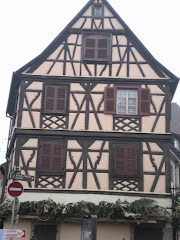This region of France is known for the Comté cheese. Here one buys the comté at a local fruitière which is a fromagerie or cheesemaking house. Each day the farmers deliver their milk to their local fruitière. It will be crafted into Comté within 24 hours maximum of milking.
We had the pleasure of visiting the local fruitière in Pleure and were treated to a guided visit of how the fromagère* makes Comté. He explained it takes 2000 litres of milk to make just 5 large rounds of Comté. Milk is delivered each morning at 3 am by many different farmers - hence it is a cooperative. Only the Montbéliarde or Simmental Cows are used for making Comté. The cheese is still produced using traditional methods. The unpasteurized milk is poured into huge copper vats which is standard for making Comté. No preservatives or additives of any kind are added. The standards are very strict for making Comté cheese. There were just 2 guys in here making the cheese, mostly done all by hand except the machinery for mixing and pouring into the molds. They make 5 molds at a time and during the winter about 16 per day. Production is increased during the summer as more milk is produced. The Cheesemaker explained the cheese tastes different depending on the season, as the cows are eating more grass in spring and summer than in winter when they have a diet of hay.
After it is poured into huge industrial molds, each is given a label and then put into the cellar where it will affinage *** a minimum of 120 days. On a rotating basis, they check the molds rubbing them with a briny liquid mixture of gros sel* and water to the tops and sides, then returning another day to turn the mold over by hand to coat the other sides.
Not an easy way to make a living, but the fromagère was proud of his work and took time out of his busy morning to show us his traditional cheese making methods. If you have the chance to visit this area, be sure to inquire about visiting a fruitère to see how Comté is made. Well worth the visit and something not to be forgotten.
 |
| Rotating the molds in the cellar |
 |
| labels added to each mold referencing day of production, month and region |
 |
| Look for the green label and the bell on each comté |
* cheesemaker
** large salt crystals
***mature















































No comments:
Post a Comment